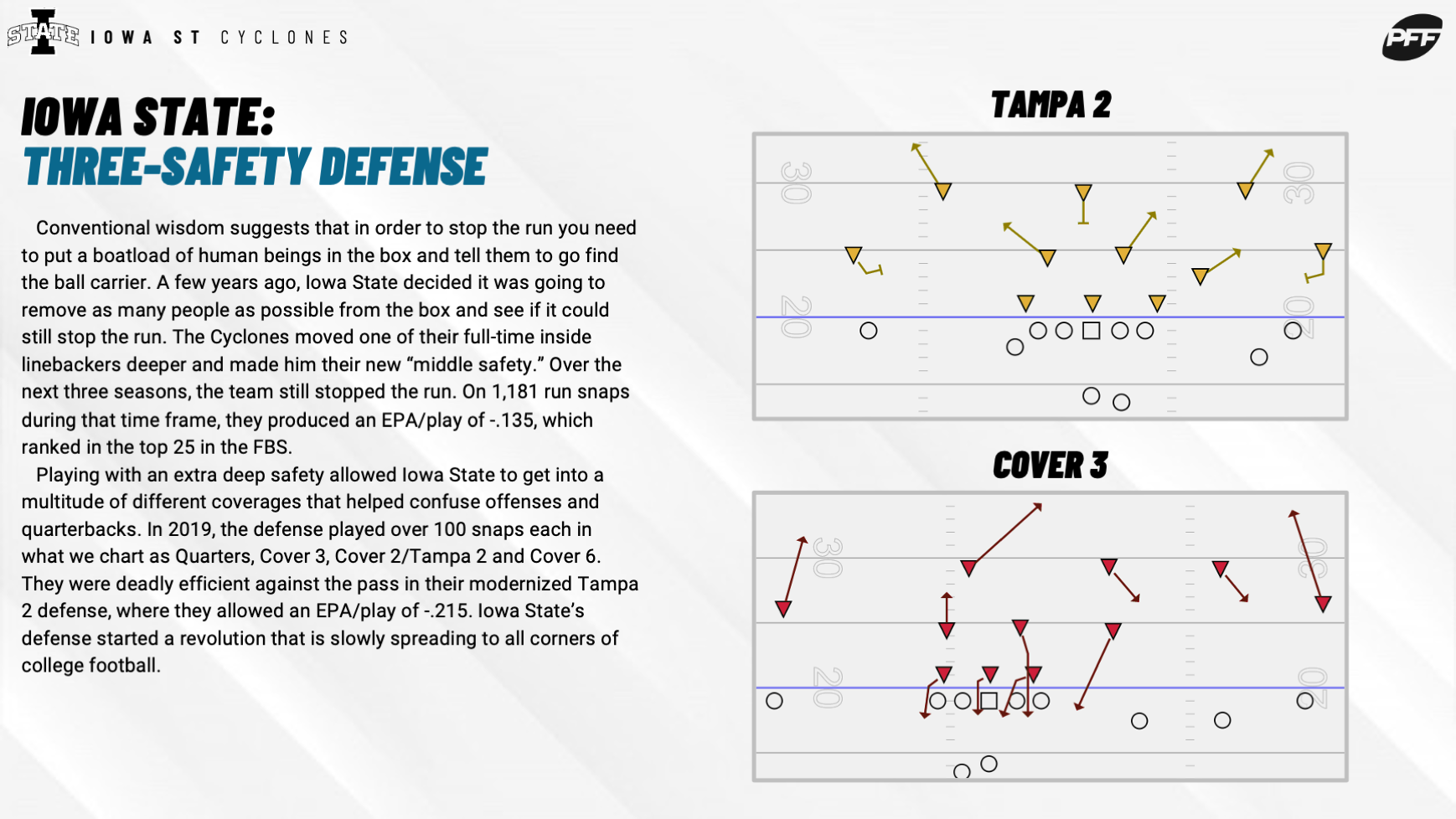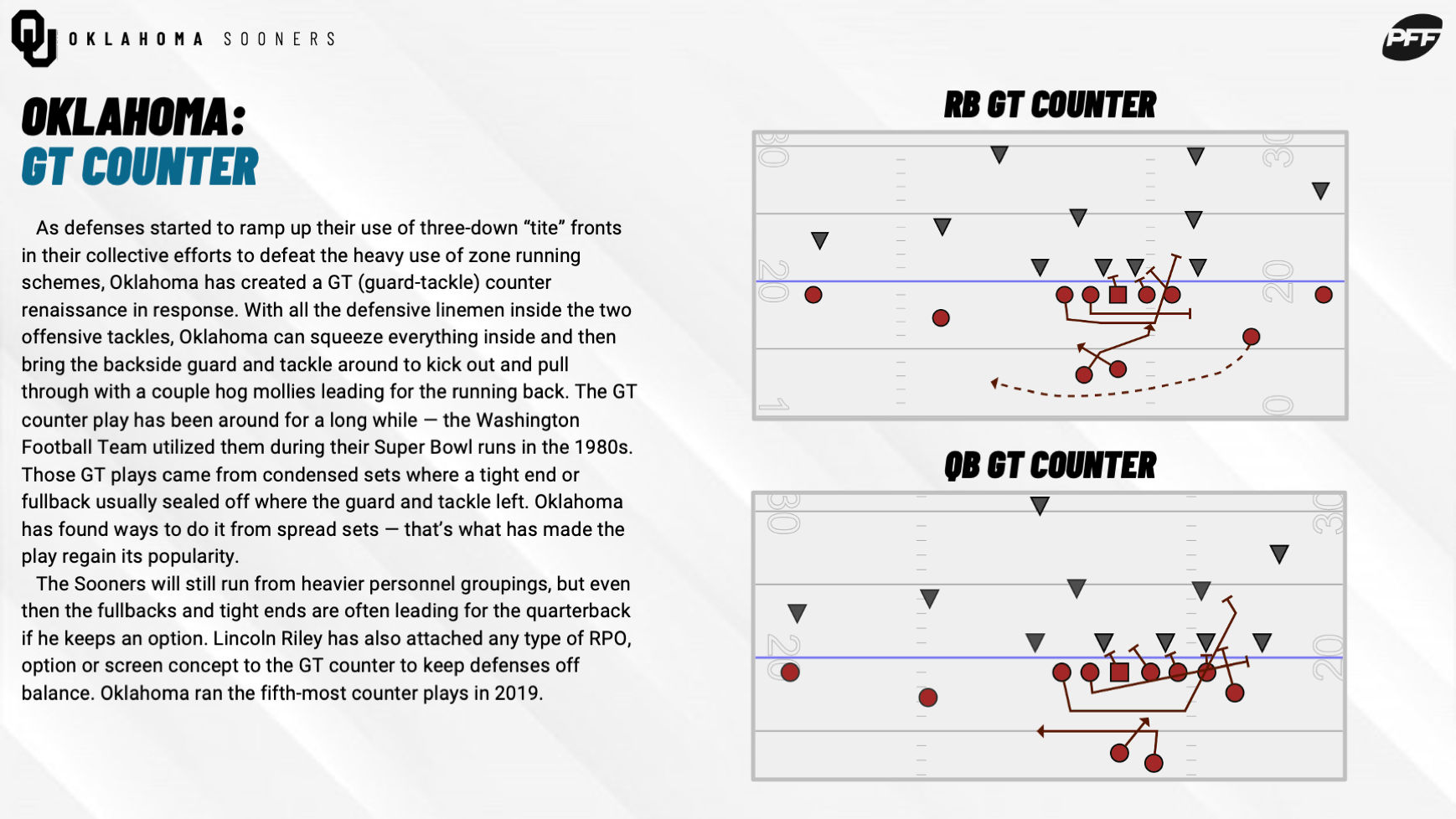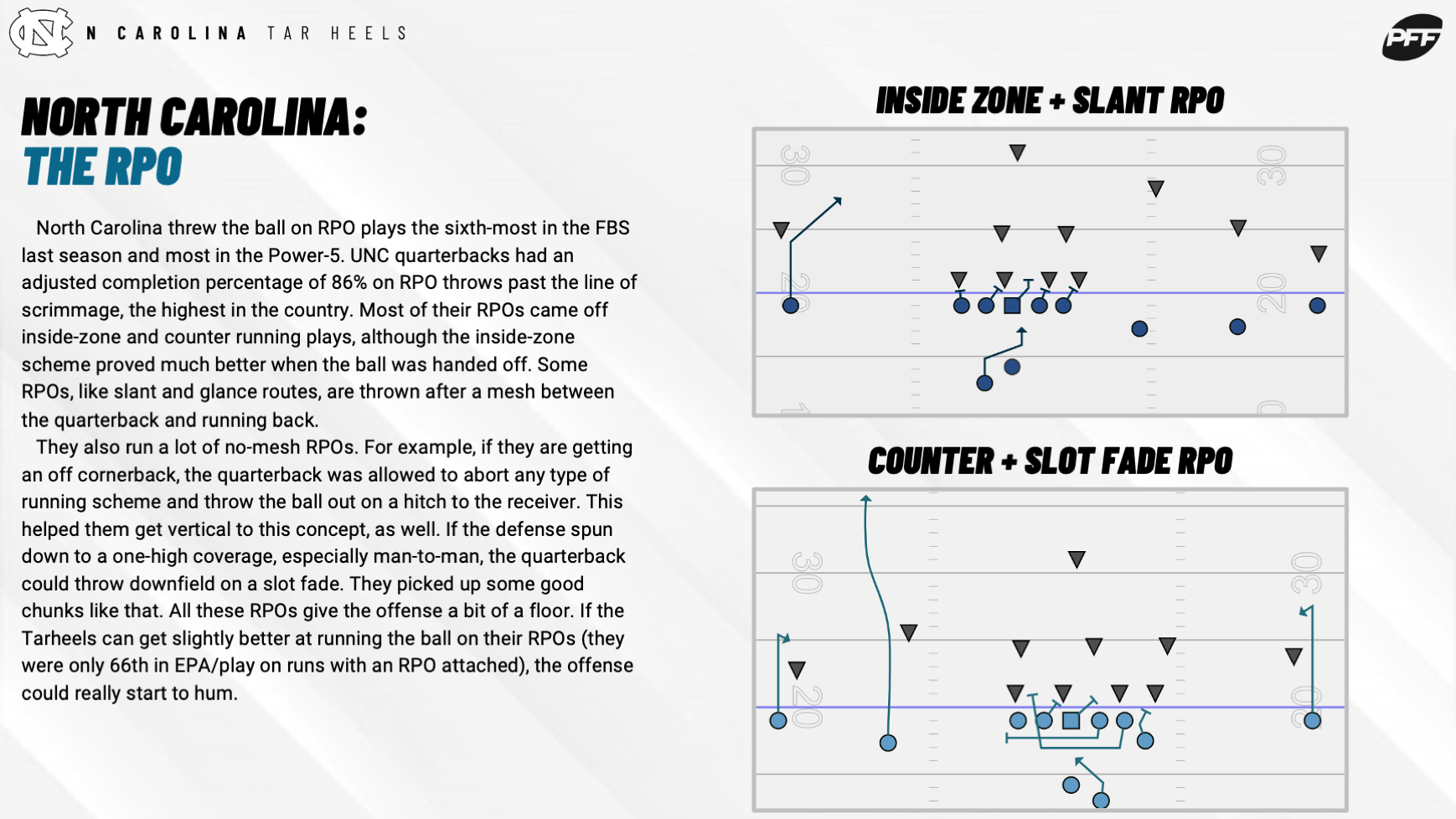If you have already had the pleasure of poring over PFF’s recently released College Football Preview Magazine, you will know that you can find everything from analysis of your favorite team’s quarterback to the biggest X-factors on each team to anything and everything in the middle. If you haven’t got your hands on a copy yet, you can do so here.
Each Power 5 team also has a page dedicated to micro- or macro-level schematic analysis. There is certainly a lot of overlap when it comes to schemes being run at the FBS level, so we’ve decided to put together five schematic trends we’ve seen over the last few years in college football.
Subscribe to
1. Tite Front
In what has become the base defense for a whole slew of college teams, the “tite front” has taken its place on the pantheon of defensive concepts that have swept the college football universe. Just a niche system only a few years ago, now so many teams have adopted this style of packing three defensive linemen inside the offensive tackles.
Because of how prevalent zone runs are in college football, having three players inside the tackles makes it hard for offenses to double-team the linemen effectively. And this allows linebackers to flow over the top easier and make plays — 120 of the 130 FBS teams ran over 100 inside-zone runs last season, so it’s easy to see why this style of defense is so useful.
It’s not that football hasn’t seen different types of 3-4 defenses that have stuffed their defensive linemen inside, it’s that teams would never allow for a “soft edge” when the offenses started to spread their receivers out. You can find 3-4 teams of yesteryear showing the three defensive linemen plus two standup linebackers in a 5-2 set because of all the tight ends and fullbacks on the field. However, using the same idea against spread teams is an entirely different look.
The “overhang” linebackers also have the benefit of being able to sit in RPO windows and force quarterbacks to hand the ball off. Once the ball does get handed, the idea is that the ball carrier will have to run laterally to gain yards because the middle is clogged up. This plays into the hands of a fast sideline-to-sideline defense.

2. The three-safety defense
Certain teams have gone a step further with their tite front alignment and pulled a linebacker off the field in favor of a third safety. This is not the “big nickel” package that NFL teams have been using for a long time, but a radical shift in philosophy in having three safeties on the field.
Iowa State might have started the trend, but many teams — including Baylor (whose coaching staff from last year is now in the NFL), San Diego State and Clemson — have picked it up and run with it.
The third safety, often called the middle safety, allows for a lot of variability in coverages, with the old Tampa 2 defense becoming a viable option again in college football. The middle safety can play his pass assignment on the way to playing the run, and it’s a lot less of an issue than the old Tampa 2 MIKE linebacker having to play run and then get deep in the middle of the field against a speedy slot receiver. Everyone who is a part of the front can fill the run quickly, knowing the middle safety will play any running back cutback from depth or quarterback run out of the backdoor.

3. Trips Nub
The so-called “trips nub” alignment has seen it’s usage rise as a percentage of overall snaps in the last few seasons. Although still not particularly prevalent — it accounted for only about 4% of all snaps in 2019 — the volume has still risen. Last season saw 4,740 snaps in trips nub, the most since we began tracking it in 2014.
Last season, Wisconsin (111 snaps), Penn State (109), UCLA (101), Florida (99) and Northwestern (93) made up the top-five in overall use. Utah’s 0.394 EPA per play led all FBS teams with at least 50 snaps in the formation, Notre Dame’s 0.742 EPA per play led teams with at least 25 snaps, and TCU was the most dominant rushing team at the fewer-than-25-snaps threshold, clocking in at 0.499 EPA per play.
For TCU, it was by far the best formation for them when it came to running the ball. Their idea — and frankly the main idea for all teams when it comes to running the ball in this formation — is to run away from the down safety. Defenses have to decide whether to keep the cornerback on his side of the field (even though there is only a tight end to his side of the field) or to move the cornerback to the opposite side of the field and bring a bigger body safety down on the tight end. If the safety was down over the tight end and the cornerback shifted over to the three-receiver side, they would run their inside-zone play to the nub side with the idea that it would cut back to the frontside where worse tacklers would be. If the defense puts a cornerback on the tight end, they would pull linemen and run the ball heavy at the cornerback. It’s a “damned if you do, damned if you don’t” scenario for the defense.
In Notre Dame’s case, it allowed them to use their star tight end, Cole Kmet, in a few different ways. By having him closer to the middle of the field than he would be in a normal “trips” alignment, the Irish were able to get him going across the field on drag routes much easier. This sometimes created a five-man concept (the three frontside receivers plus the tight end and running back flaring out) to one side of the field that gave defenses fits. They could also use him from that tight-split alignment to run corner routes and play a combination game with the running back on smash concepts. Overall, Kmet graded out to an 89.1 receiving grade in this formation.

4. Counter
Because of the increased use of the tite front to defend zone-based blocking schemes, offenses have answered by running counter schemes at a higher rate than ever.
FBS teams ran 5,206 counter plays last season, up from 5,071 the year before, which was up from 1,418 in 2014. In fact, the volume of counter plays has increased every single year since 2014. The zone-stopping defense has created great angles for offenses to down block and then have big bodies pull around to create big running lanes.
Clemson’s 0.381 EPA per play led all FBS teams with at least 25 snaps of counter a season ago. With the increased usage of the “h-back” in college football, they’re able to pull the backside guard to kick out opposing defensive ends and then have the backside h-back lead through the hole.
That’s how most teams are running counter. However, one of the trendiest ways to run counter is with the backside guard and tackle pulling around. This “GT Counter” has been around for a while, though Oklahoma has made it popular again.

5. Third-level RPO
Defensive coordinators have long been up in arms about the prevalence of the RPO, and now that almost every offense in college football has fully incorporated them, defenses are not going to be seeing any less of them over the next few years.
The newest advent is the “third-level RPO,” where, instead of reading a first-level defender (such as a defensive end for a quarterback-option run) or a second-level defender (such as a linebacker for a quick slant pass), the quarterback looks to the third level and the deep routes they are paired with.
LSU made a living on the third-level RPO, where they would read the rotation of the safeties to see whether Joe Burrow should pull the ball and throw a glance-post to the receiver for a big gain. You’ll also find teams that will read the safety rotation and not even put the ball in the running back’s gut in order to throw downfield seam routes. If, on the snap, the defense gives them a look they want, the quarterback is taught to throw these one-on-one routes down the field. It’s very frustrating for defenses, there’s no doubt.
There were 2,137 RPO throws in 2019 where the target depth was 9 yards or beyond. Liberty led the way with 60 of those snaps, and 22 of them were go-routes. If the quarterback likes a one-on-one matchup present and there’s no safety splitting half of the field, he just takes the snap and throws the ball up. The offensive line doesn’t have to know, nor does the running back — they’ll continue on their tracks for the called running play, but the ball will be thrown for a big gain.

Join today to get your hands on the magazine along with our new college football subscription packages that will provide insight into college football like never before. Using the promo code “CFB25” you can obtain a 25% discount on your purchase!



 © 2024 PFF - all rights reserved.
© 2024 PFF - all rights reserved.